Review: The Bugei Bamboo (Part One)
Sept 9, 2010 11:47:47 GMT
Post by Midori Kawakami on Sept 9, 2010 11:47:47 GMT
Disclosure
I bought this sword second-hand at a police auction for an obscenely low price, probably pennies on the MSRP dollar.
Note: This is part one of a comparative two part review. The reason for a two part review is this: I bought this sword second-hand and a little worse for wear, so I want to give the review a second go when I have the sword restored to its original glory.
Introduction
Ohayo gozaimasu, SBG!
After much deliberation, I have decided to review my favorite and most valuable production blade, though it was by no means my most expensive. It came to me second-hand, through a police auction and I got it for an obscenely low price. It's always been in need of some work, but it is now in the process of a full restoration. This sword is my Bugei Bamboo.
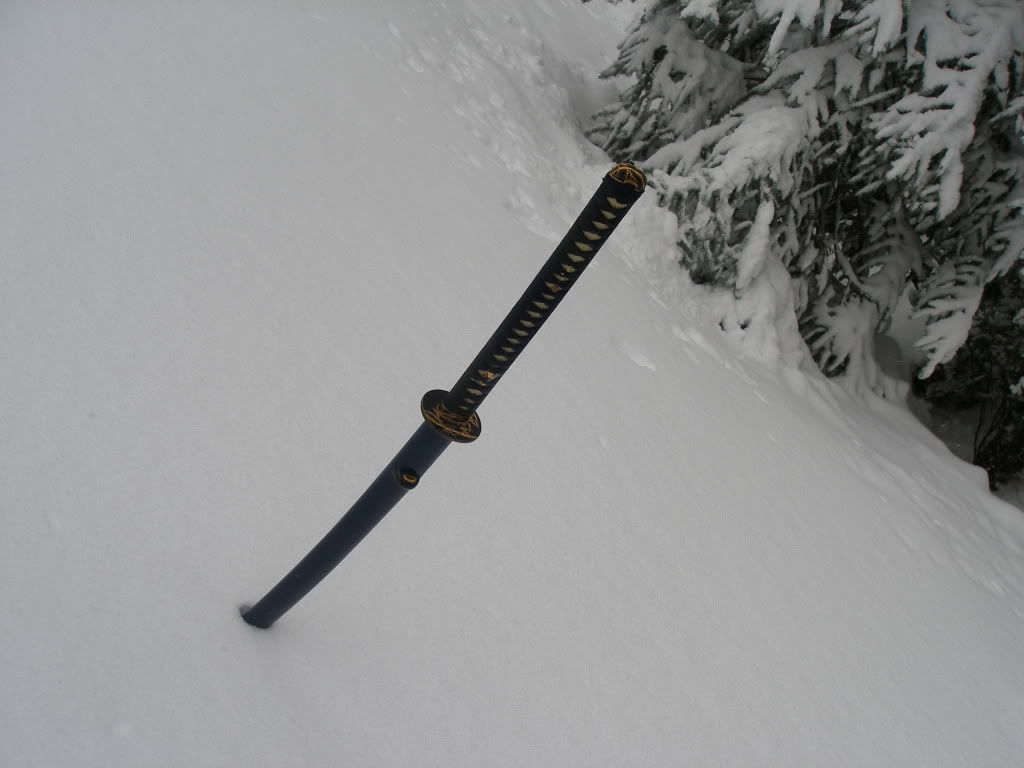
Bugei Bamboo, shortly after I received it from the police auction two years ago.
Historical overview
Bugei takes great pride in the fact that they base all their swords off of historic designs. The Bamboo is their oldest design, and seems to be based on swords from the Nambokucho era of swordmaking (1333-1391).

Bizen Ukai, also called Unrui, Ugai, or Unkai from the Nambokucho era. Notice the robustness of the blade. This blade was certified Juyo Token by the NBTHK in 2000. Source: www.japaneseartswords.com/node/34
Blades of the Nambokucho era were known for their robustness and size. This era was characterized by some absolutely massive swords, many of which were shortened, most memorably during the time of the Tokugawa Shogunate. There are few surviving examples of ubu (unshortened) Nambokucho blades.
The Bugei Bamboo is a monstrous blade. Weighing in at an impressive 3.1 pounds, it is the heaviest functional katana in our entire collection. Bugei advertises that this sword has 'moderate niku', but in comparison to other production blades I've handled, I'd almost call it heavy niku. It's a very robust blade, and you certainly know it's there when you have it in hand. It does a phenomenal job of mimicking those big, robust blades of the Nambokucho era, save for the fact the kodogu are not true to the time period, as katana mounts were not introduced until the Muromachi era (1392-1572).
Initial Impressions
I apologize for lack of unpacking photos; I acquired this sword about two and a half years ago, before I ever considered reviewing a sword or knew that there was a demand for it. In exchange, here is the story of how I came to acquire this sword in the first place.
Hyoujinsama and I like to look in strange and unexpected places for swords. Chances are, if you find a sword where it doesn't really belong, you can get a good deal on it. One evening, he was browsing a police auction site and saw some very bad photos of this sword. He called me over to his desk, then said: "Hey honey, I think that's a Bugei Bamboo. It's too small for me, though; site says the blade is 27 1/2". Should I bid on it?" My eyes must have been as big as saucers; I said "YES. I want it!" So he bid on it and we kept an eye on the auction. It ended at $53.00 with us as the highest bidders. Shipping was $15.00, bringing the total up to $67.00.
It took the sword about a week to get here; it didn't have far to travel, as it was already in Southern California. It was packed well, though the blade itself was in a state. The sageo was missing, the kojiri was scuffed up, the koiguchi had gashes inside, the saya was scratched, and the blade itself looked like someone had gone edge-on-edge with another sword with it (I assume that's how it ended up at the police auction to begin with). There were chips and scratches nearly the entire length of the blade, along with a nice kirikomi in the shinogi. Additionally, it appeared as though someone had attempted to cut the dirty ito off with a knife. Kevin unwrapped the tsuka and washed the ito, then shortened the tsuka from 14" to 12" and reused the same ito after trimming the cut part. He also sharpened it and worked on the chips in the ha.
What stood out to me was, despite the fact the sword was so badly abused, the quality was evident. What hada and hamon we could see was gorgeous, it had very high quality same on the tsuka, and the ito was silk. The menuki and shitodome were gold plated, as was the detail on the tsuba and fushigashira. The lacquer on the saya was a beautiful deep blue, which also told us about this sword's age; by then, Bugei had ceased production of the blue saya in favor of black. It also meant that this sword was made of Manchurian rail steel, as the first production models of this sword were. They ceased production of the MRS blades about the same time they began painting the sayas black.
When I first handled the sword, I felt right away how heavy it was and at the time, it was too heavy. I've since worked my way up to being able to use it; it's amazing how useful kata is as a strength training tool! The tsuka was, of course, too long...and stick straight. Since Kevin has shortened it, it's a more manageable length for me. It's never sat quite right with me that this tsuka isn't even waisted, however; for the price, I'd expect something more historically accurate.
The Bugei Bamboo retails on Bugeis' site for $1,470.00.
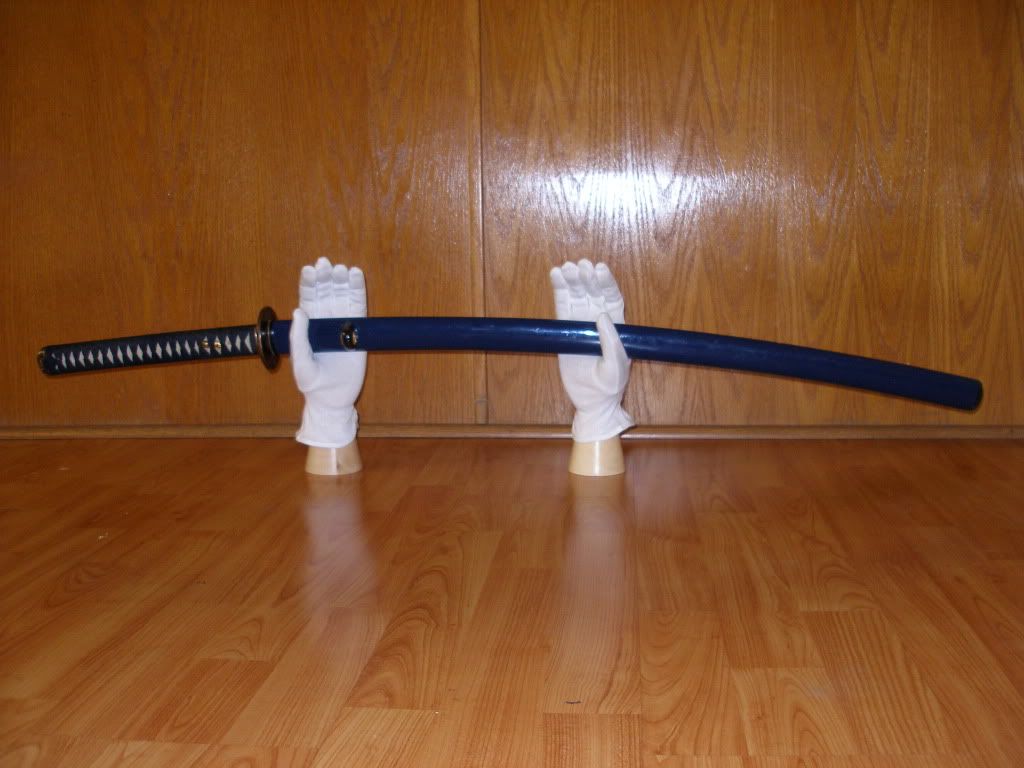
Statistics
Nagasa: 27.5"
Tsuka: 12" (Shortened from 14")
Overall Length: 41"
Tsuba Width: Just a hair under 3"
Point of Balance: 5" from tsuba
Weight Without Saya: 3.1 Lbs.
Components
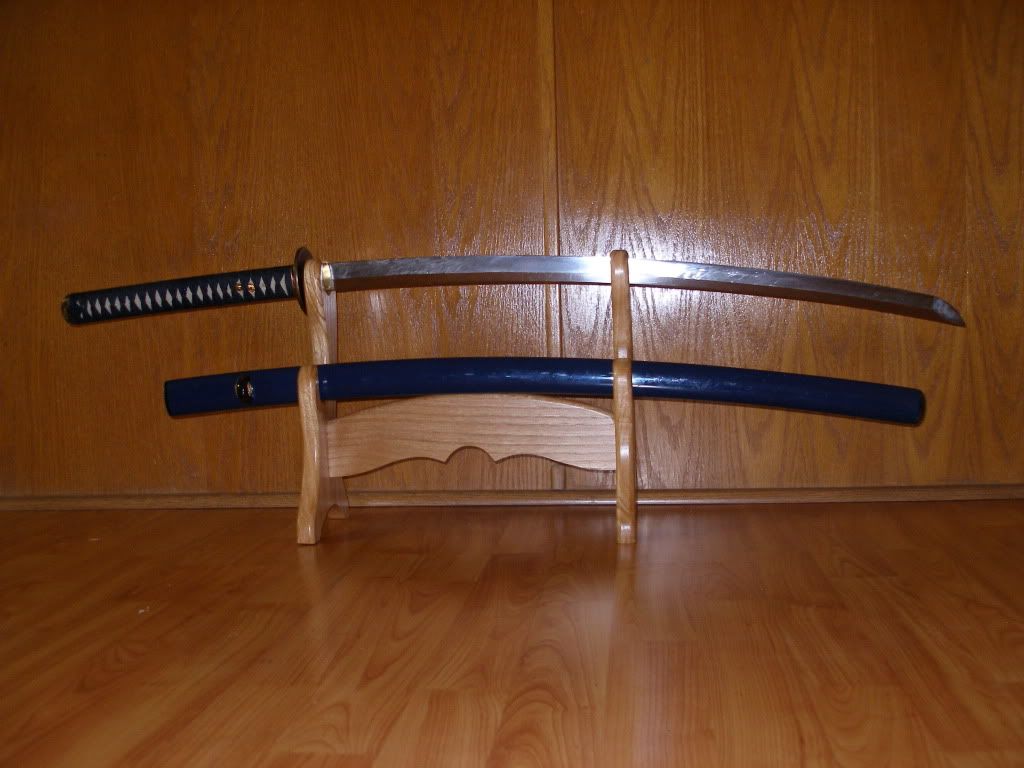
Toshin
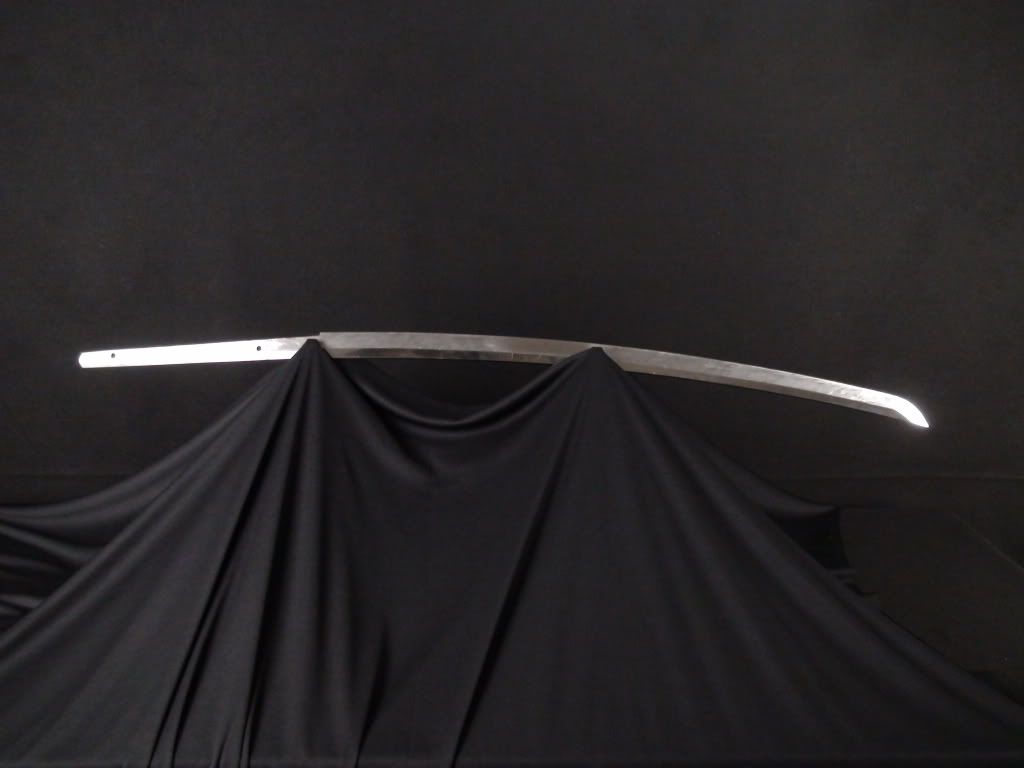
Bare blade of my Bugei Bamboo. Old photo.
The blade is very Nabokucho-esque. While it only has a 27 1/2" nagasa, it has a lot of niku, which gives the blade its considerable heft. It is forge-folded and made of Manchurian rail steel. It has high sori of 1" and a geometric yokote. The hamon is real, created by the claying and quenching process. I can only imagine what this blade may have looked like new and am anxious for it to be restored.
There are some things that I'm less than thrilled with when it comes to this blade, considering its high retail price. First is the kissaki. While I do love the fact the yokote is geometric, the two sides of the ko-shinogi don't match up. This is evident in the photos below:
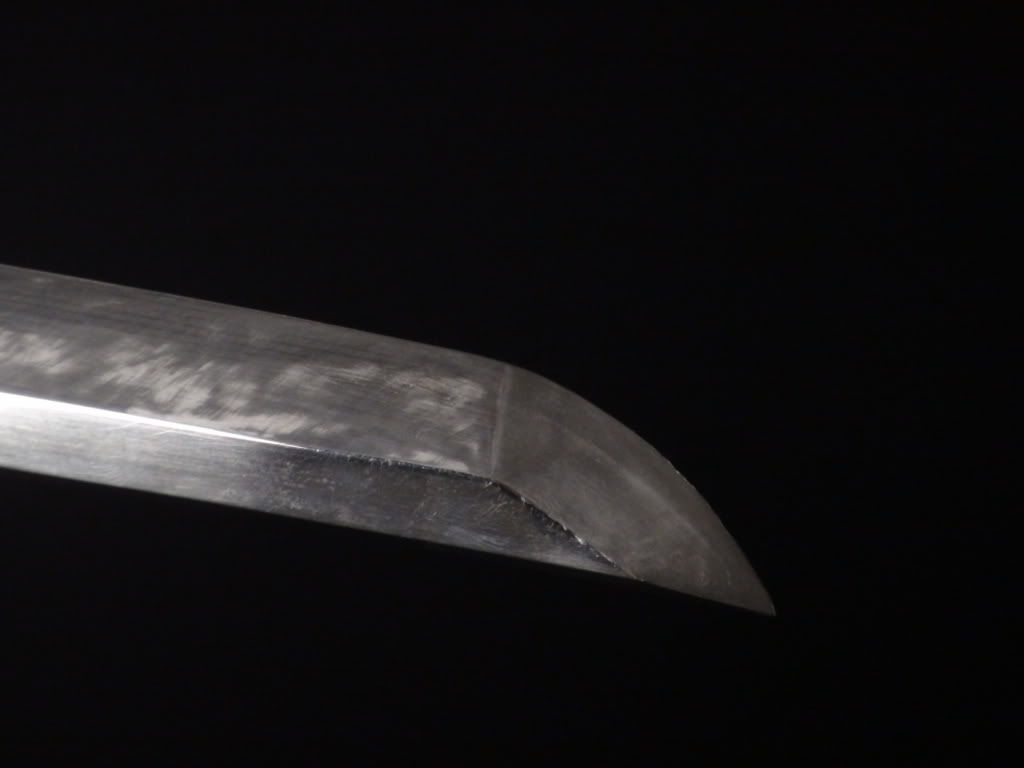
Kissaki, right side
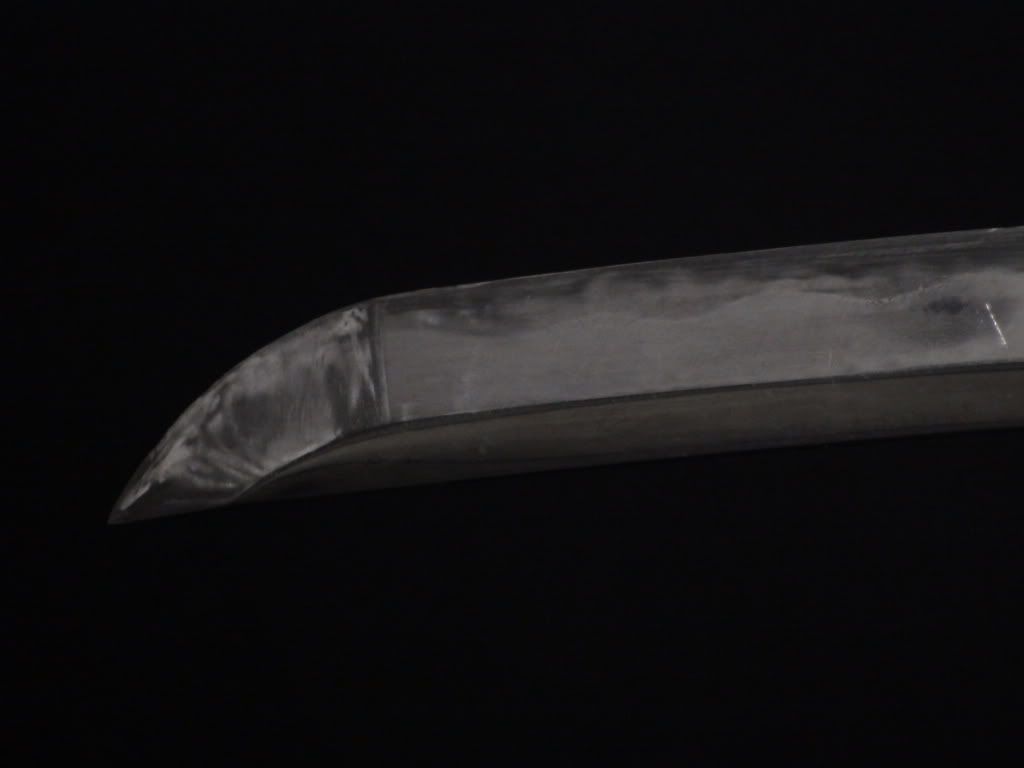
Kissaki, left side
You can clearly see that while the ko-shinogi on the right side has a proper, rounded shape, the one on the left is straight. It's only a cosmetic imperfection, but on a $1,500.00 sword, I would expect the ko-shinogi to match.
From what I can tell of the main body of the blade, it's got some really lovely mokume and itame hada and a nice gunome hamon. I'm eager to see it polished.
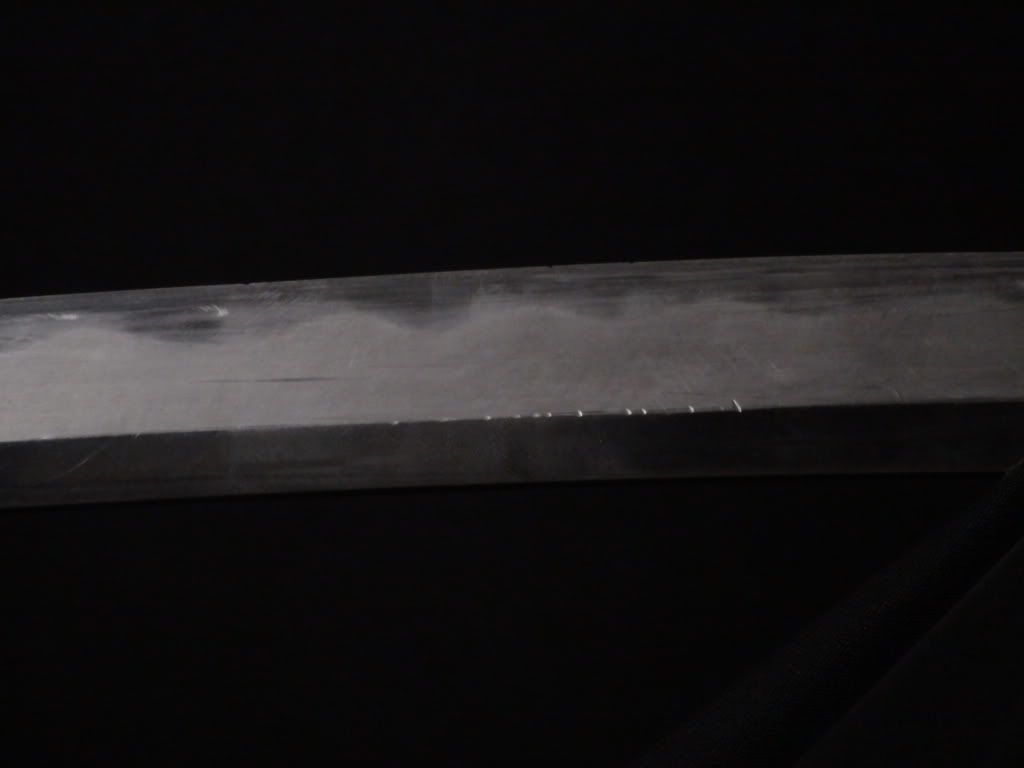
Close up of blade. Notice hamon, hada and scratches.
My second issue is that the nakago is stick-straight instead of curving with the blade. For the retail price of this sword, I would expect a bit more effort to be made in regards to this.
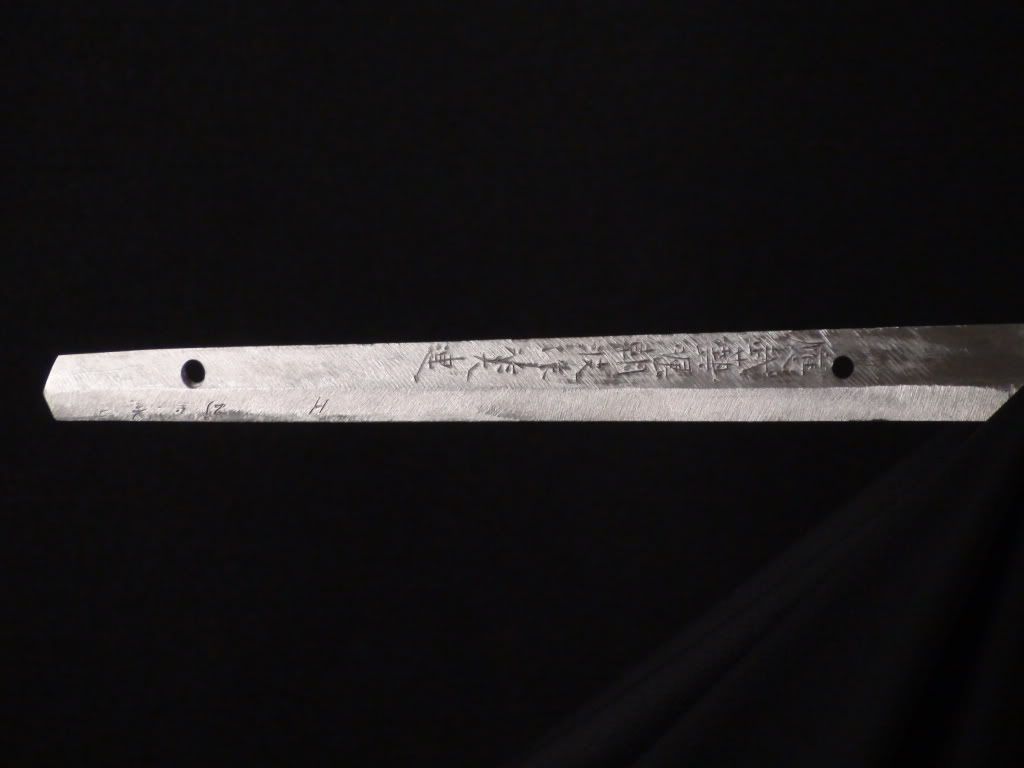
Nakago, left side. This sword was #21 of its production run.
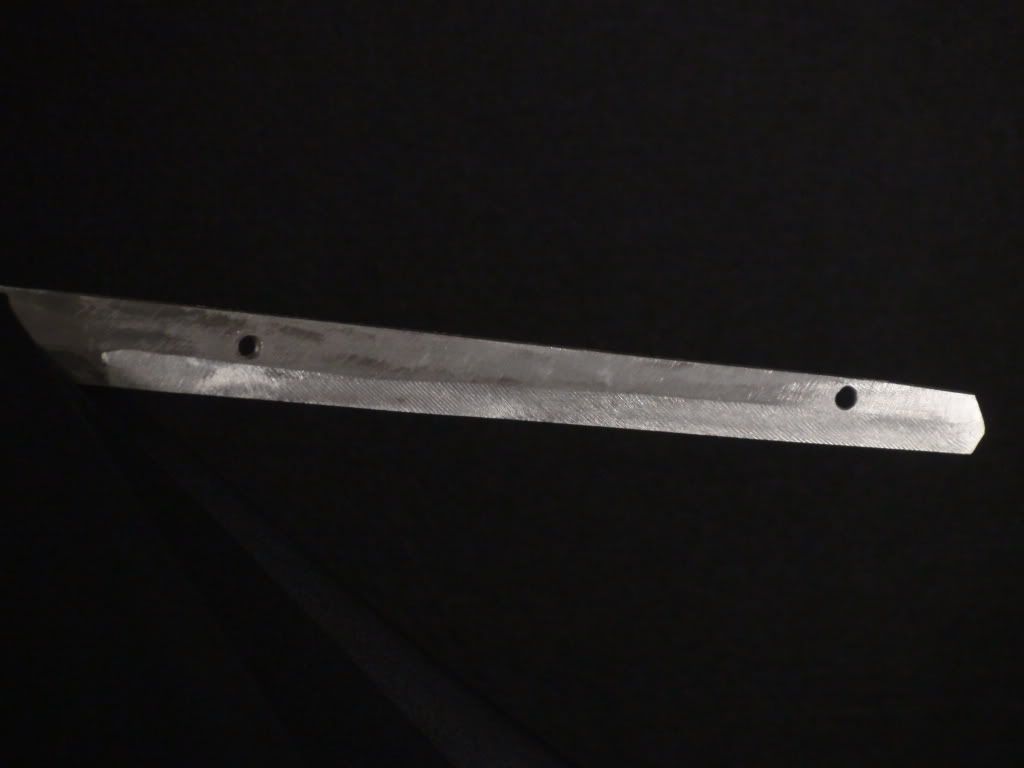
Nakago, right side.
Still, despite its' quirks, I do love this blade, and I know I got a fantastic deal on it.
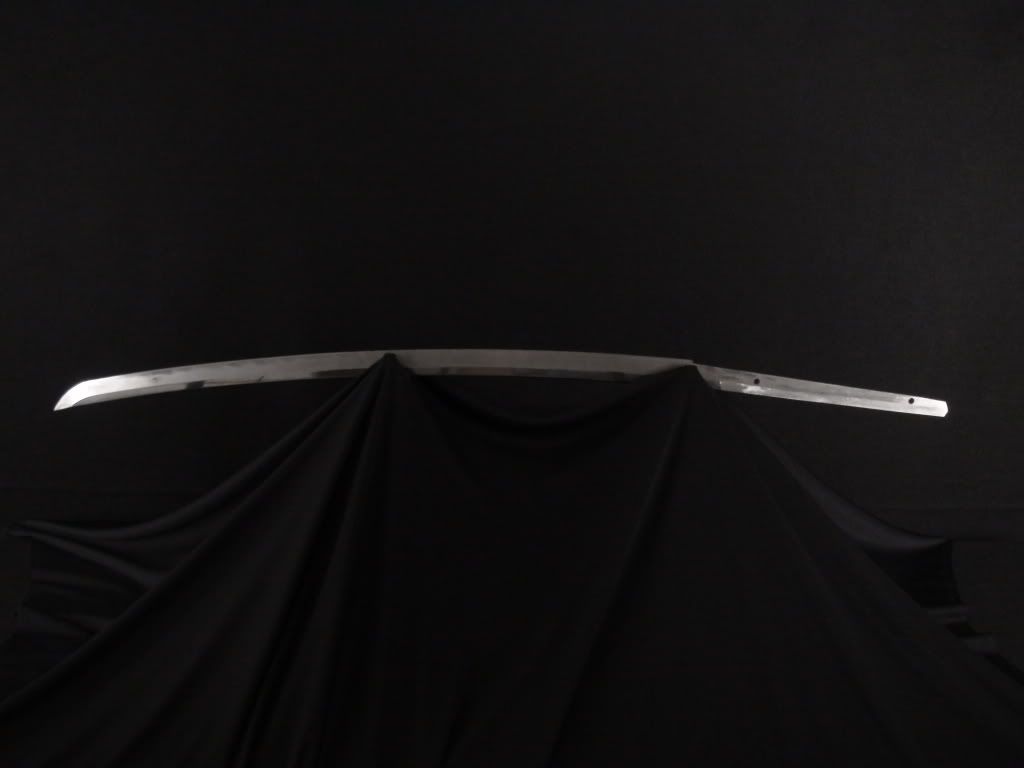
Full right side of the blade.
More photos of the blade, showing sori and niku:
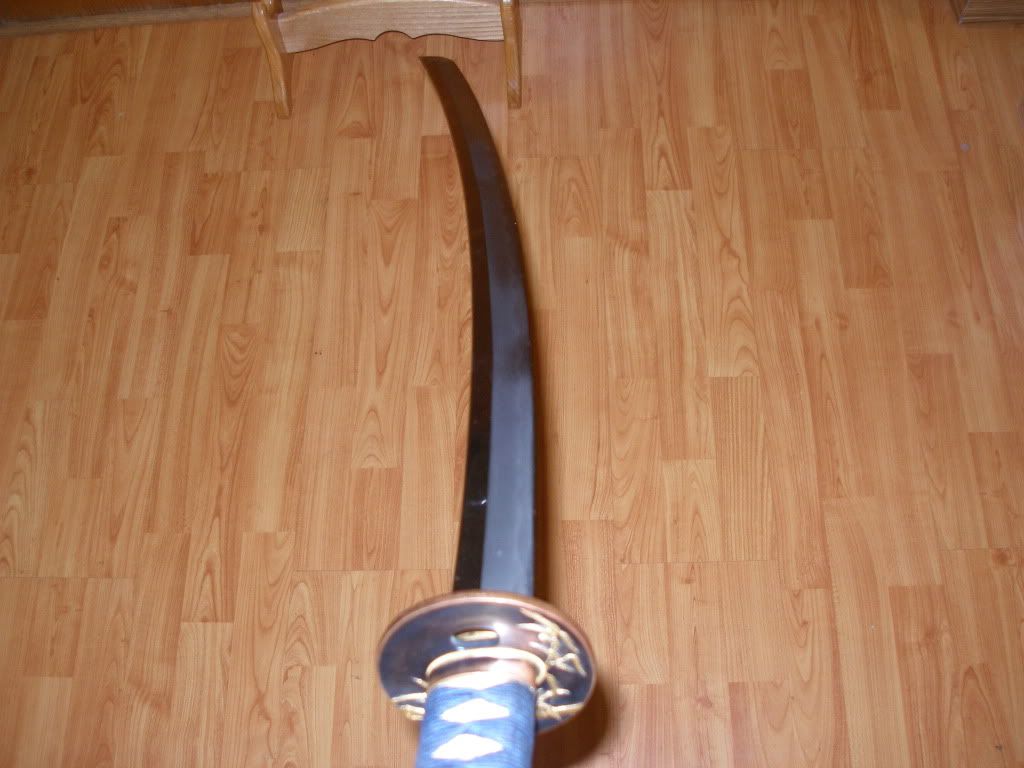

On a final note, the habaki fits the sword well. I just wish it had been constructed of copper or nickel silver instead of brass.
Tsuka
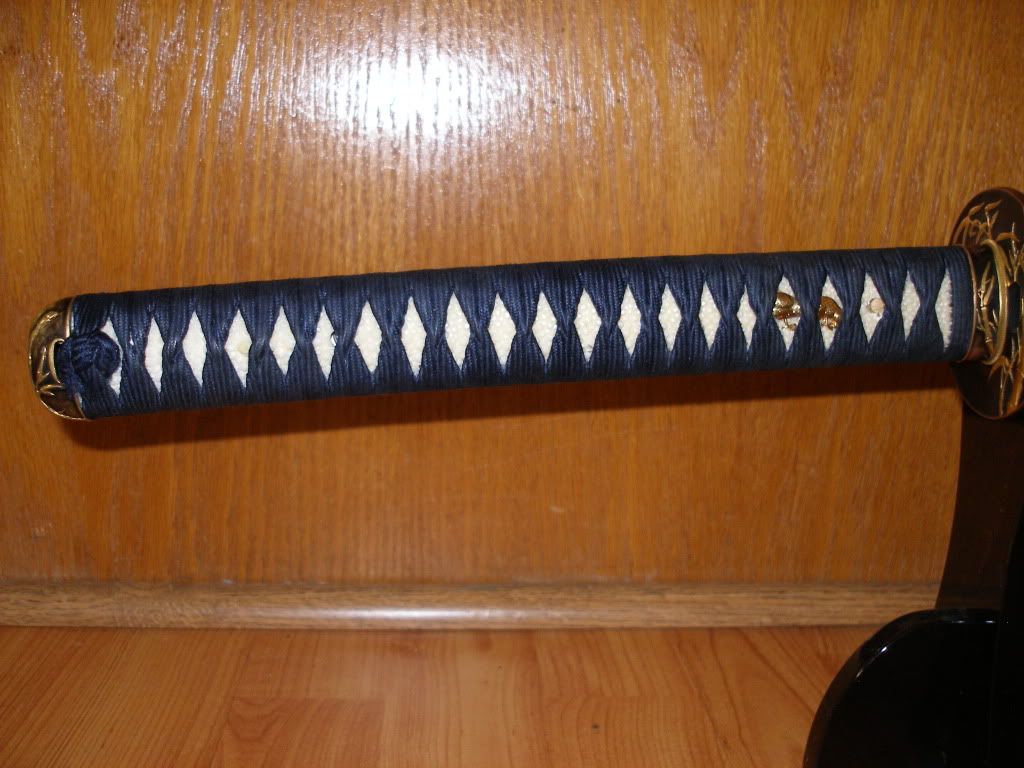
The tsuka is another sore point, as it does not taper at all, it is stick straight (imogata) and it is not waisted (rikko). It's rather reminiscent of Hanwei's 'axe handle' tsuka. While this is somewhat understandable because Bugei is produced by Hanwei, it is inexcusable in a sword of this price range. It's saving graces are alternating silk ito in blue (which has been discontinued), hishigami and high-quality samegawa.
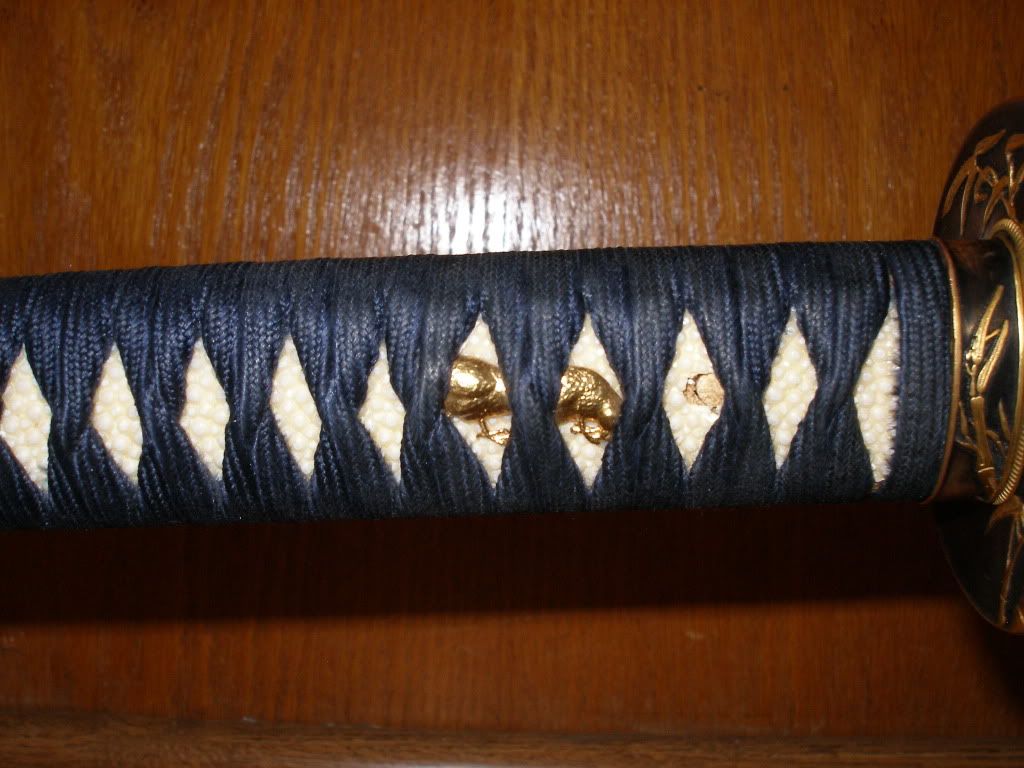
Close up of menuki
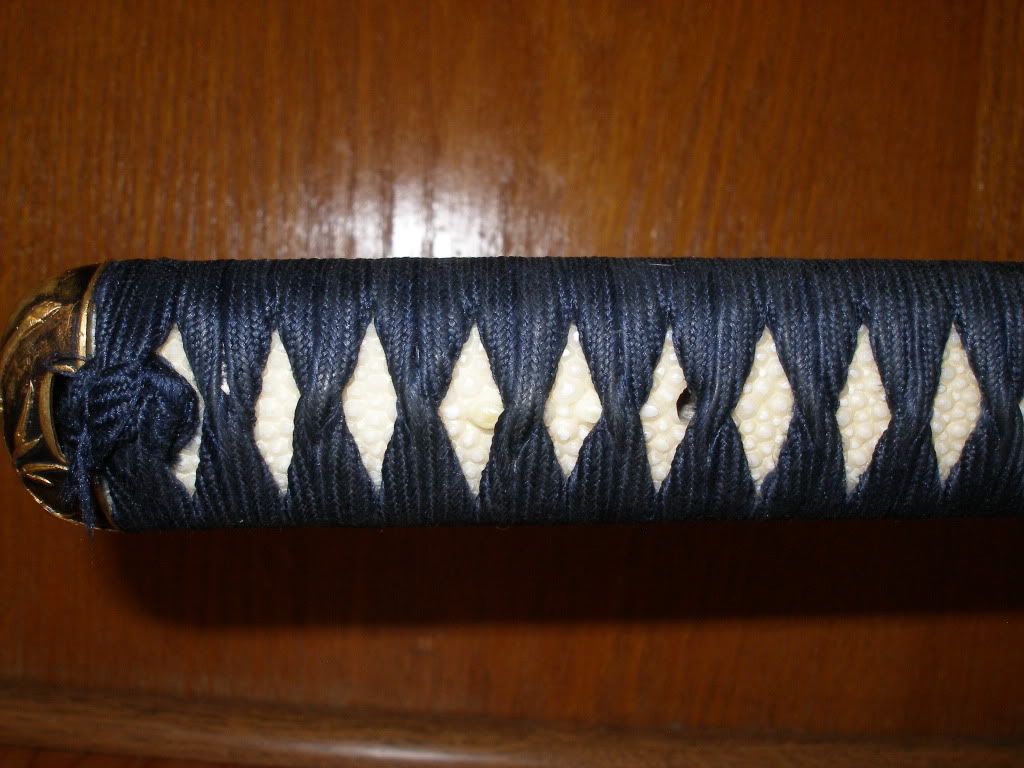
Close up of samegawa. Notice the large oyatsubu, or Emperor's nodes.
These photos were taken long after the tsuka shortening and cleaning/rewrapping of the ito. The tsuka was originally 14" long, which was much too long for me to be comfortable with. I would end up hitting myself in the stomach when I tried to execute a dodan cut with the sword. The removal of just two inches of material made quite a bit of difference. It's a much better length for me to use, now.
Tsuba
The tsuba on the Bamboo is made of copper and has been blackened. 14 karat gold has been painted onto the bamboo on the tsuka side of the tsuba, giving it a striking contrast. On the blade side, the bamboo is simply yet elegantly etched on.
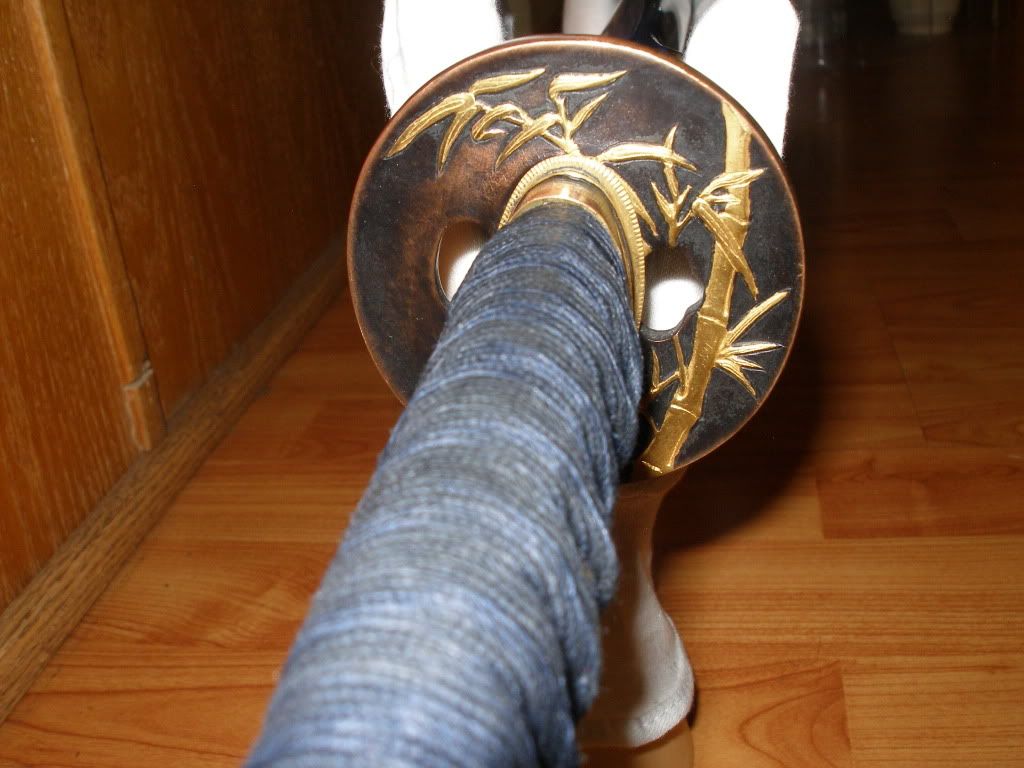
I really love this tsuba. Aside from a set of antique Edo era koshirae that I own, this is my favorite. It's elegant and not overdone, and is warm with signs of wear.

Fuchigashira
The fuchi and kashira are also blackened and painted with 14 karat gold, matching the theme of the tsuba. The fuchi is copper, but I have a sneaking suspicion that the kashira is brass, due to how it has aged. Despite this, I love their appearance and how well they fit the theme of the sword. They are most certainly the nicest set I own, save for my antique pieces.
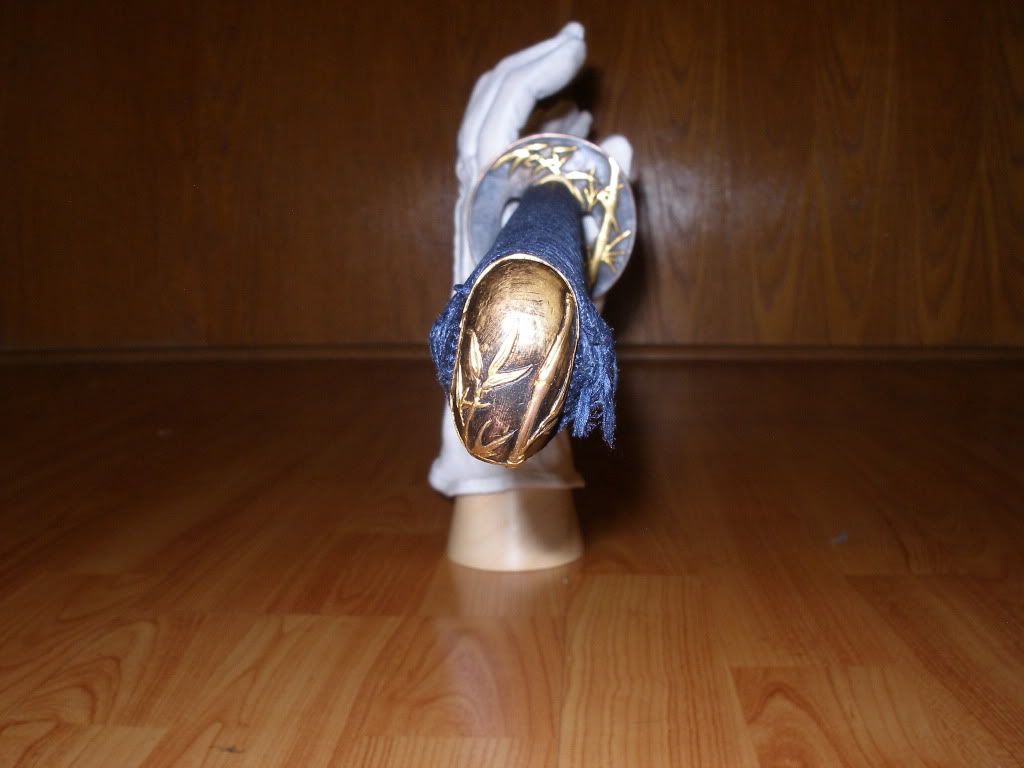
Please pardon the fraying ito. It will be replaced soon.
Saya
The saya, while in a state of disrepair, is another thing I love about the sword. It's such a deep, mystifying blue, and it's really a shame that Bugei discontinued this color. It is the same color as Hanwei's Golden Oriole and Orchid swords. Again, I anticipate the time this is restored to its original condition, as I'm going to have it repainted the same shade of blue.

The kurigata, koiguchi and kojiri all are augmented with black buffalo horn. This will all either be restored or replaced with more horn, as I really like the look of it, and it's very traditional. Additionally, the shitodome in the kurigata have been gold plated and secured in place. The black, blue and gold makes for a lovely contrast.
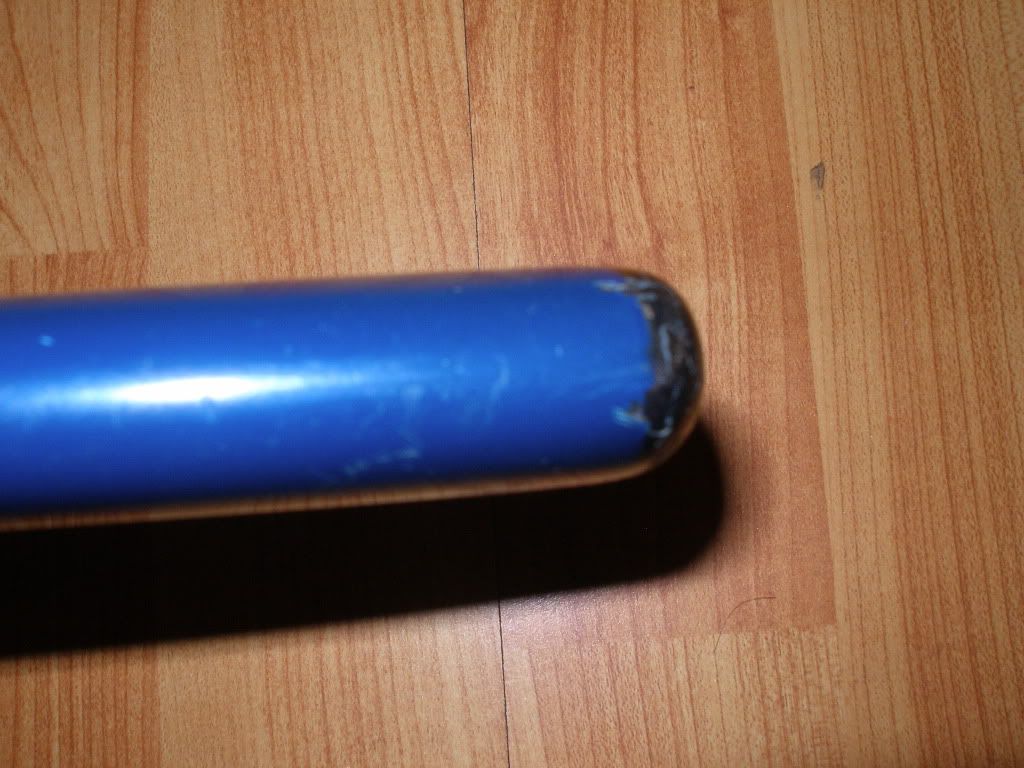
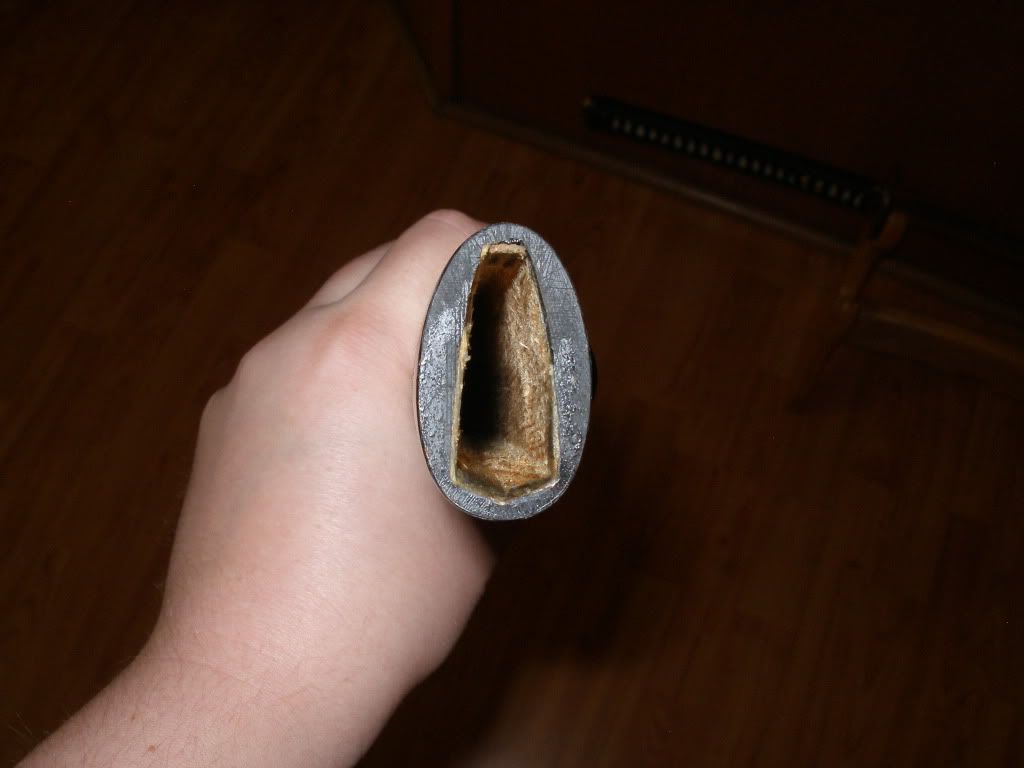
Kojiri and koiguchi are a little worse for wear, though the kurigata is in near-perfect condition.
Handling Characteristics
Nambokucho era blades were built to be big and heavy, and even after so many were shortened due to the edicts on sword length passed by the Tokugawa Shogunate (among others), they were still big, heavy blades, though most were no longer as long as they once were. Even today, surviving examples of Nabokucho pieces can be found, and the ones that have not been polished to within an inch of their lives are very robust. The Bamboo is very reminiscent of a suriage (shortened) Nambokucho era blade; at 27 1/2", it's shorter than a Nambokucho would have been in its' heyday, but is about the size of one that has been shortened. And it handles as such. Weighing in at 3.1 lbs, it's not a light little competition cutter, but has been made to be used on more traditional, large and hard targets, such as multiple-rolled tatami mats, bamboo, and tatami with a bamboo core. While I would not attempt speed-cutting with it, such as tombogiri, I have cut bamboo with it, as well as scores of tatami mats.
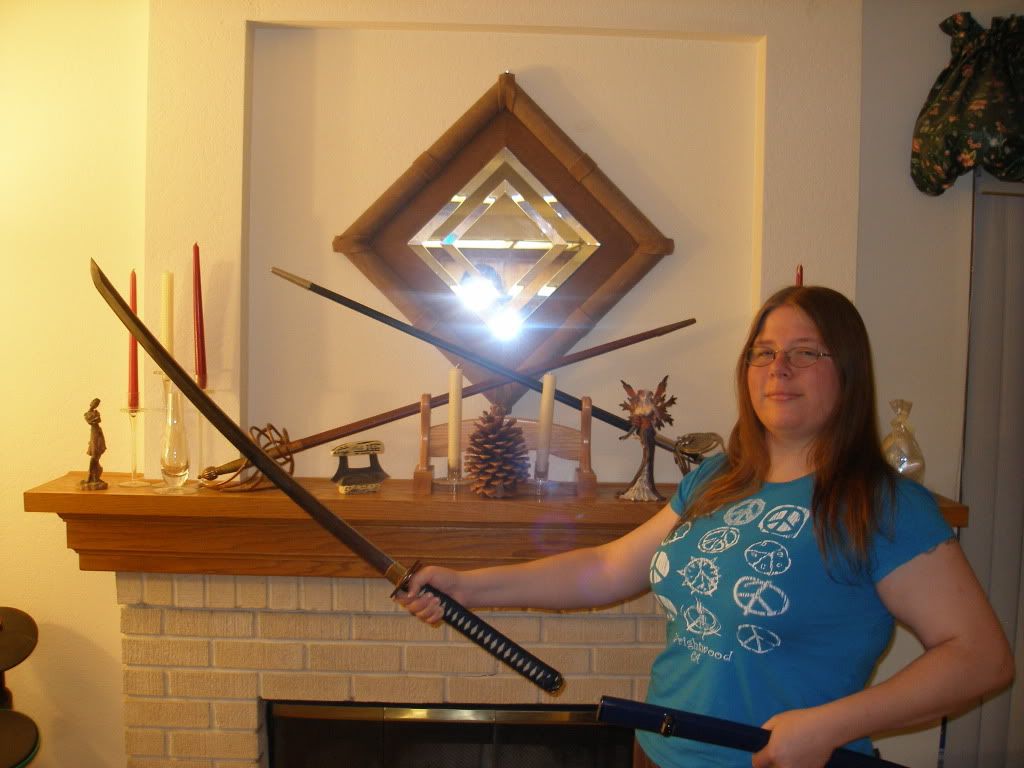
The author with the Bugei Bamboo. Author is 5' 7" and has studied iaido for 6 years. Also pictured are two rapier in the background; can you guess what brand and model they are?
As a side note, a sword of this weight isn't for everyone. I had to work my way up to being able to wield this sword effectively, as it is on the heavier end of the katana spectrum. I did strength training by working on my iai kata and doing tameshigiri with lighter swords until I could better use the Bamboo. While i love it (and part of the reason for that is its considerable heft), I would not recommend it to someone who has problems with heavier blades, because this sword is an entirely different beast from anything I've ever used.
Test Cutting
Allow me to begin this section by saying I do not and will not cut water bottles with this sword. In my possession, it has touched nothing but traditional targets.
That being said...
This is my absolute favorite sword to cut with. Because of its weight and impressive niku, it challenges me. It doesn't cut like any other sword I've reviewed; targets won't stand, because the niku is too thick, and it's unsuitable for any type of speed cutting due to its weight and geometry. It actually takes proper technique to make this swords' capabilities really shine, and that puts both the user and sword in harmony, in balance, the way a good tameshigiri session should be.
With this sword, I've cut three different types of tatami, multiple rolled mats and mats with bamboo cores over the course of the two and a half years I've owned it. It has never failed me and it never ceases to amaze me, because with this sword, I truly discover what I'm capable of. I love wielding this beastly blade.
I believe it's had a cameo in every cutting video that I've been in, and will have many more in the future. I will be cutting with it this weekend, and may post photos or videos (or both) of the cutting session at that time.
Conclusions
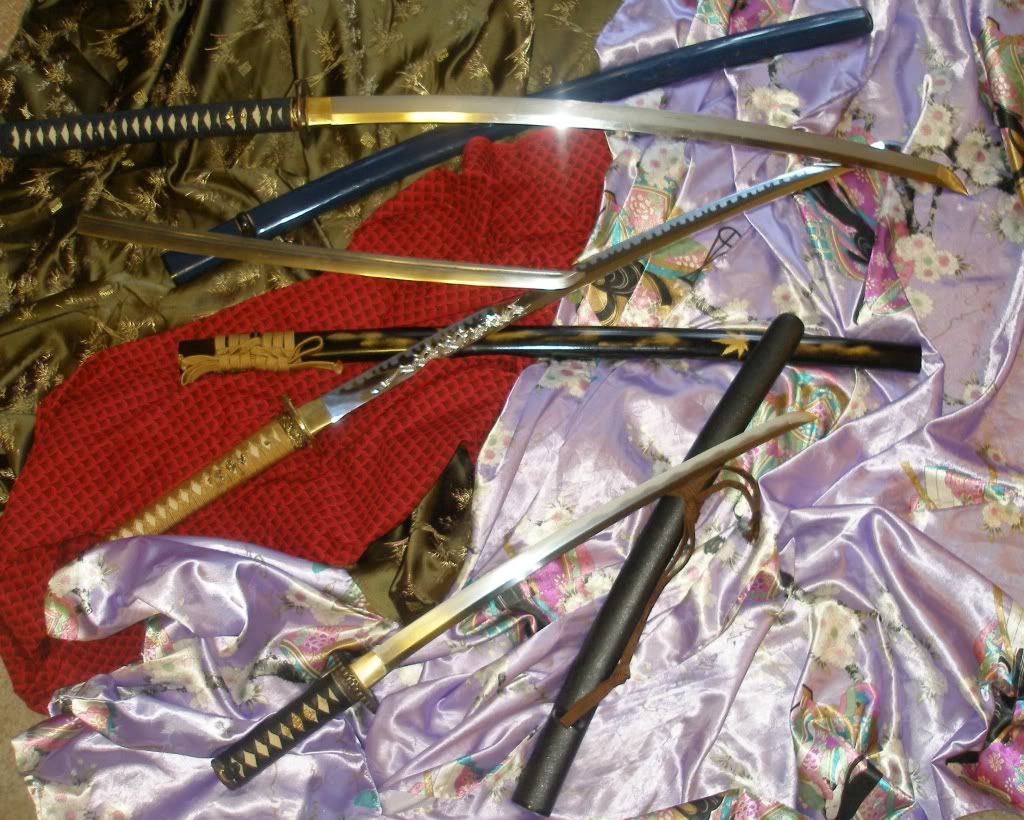
From top: Bugei Bamboo, broken Shinshinto era wakizashi, Japanese-made mogito, Hanwei Practical Plus wakizashi.
As a whole, I really love this sword. It has most of the qualities I love: It's heavy, it's made of folded steel, the aesthetics are wonderful and the fittings are of excellent quality. However, the faults that I find present in this sword, while minor, are too blatant and numerous to ignore in a sword of this price range. I would be willing to overlook them if the Bamboo retailed for one third of its' hefty, nearly fifteen-hundred-dollar price tag, but at that price, the flaws should be nonexistent. While I got the deal of a lifetime on this sword, I would not consider buying a Bugei new, though another Bugei, second-hand for a decent price may pique my interest.
I would like to see the problems with the tsuka and nakago amended in a sword of this price, and it would be lovely if Bugei brought back the striking blue color for saya, ito and sageo. There's enough black swords on the market as is, and everyone likes a little color occasionally.
Pros
- More or less accurate to Nambokucho era blades
- Very nice, high-quality fittings
- Blade made of folded Manchurian rail steel
- Price that I bought it for, second hand
- Not the average, tired production katana with black saya and ito
Cons
- Stick-straight, non-waisted, 'axe-handle' tsuka
- Ko-shinogi misshapen
- Tsuka too long
- Stick-straight nakago
- Exorbitant retail price
The Bottom Line
My feelings are mixed as to whether I would recommend this sword to someone or not. While I really love the sword, I personally can find no reason to justify the retail price, other than the manufacturer's name. If one were looking for a heavy, high-end sword, I would recommend it with the stipulation that they attempt to find one used for $700.00 or less.
Please watch for the second installment of this review, coming soon.
I bought this sword second-hand at a police auction for an obscenely low price, probably pennies on the MSRP dollar.
Note: This is part one of a comparative two part review. The reason for a two part review is this: I bought this sword second-hand and a little worse for wear, so I want to give the review a second go when I have the sword restored to its original glory.
Introduction
Ohayo gozaimasu, SBG!
After much deliberation, I have decided to review my favorite and most valuable production blade, though it was by no means my most expensive. It came to me second-hand, through a police auction and I got it for an obscenely low price. It's always been in need of some work, but it is now in the process of a full restoration. This sword is my Bugei Bamboo.

Bugei Bamboo, shortly after I received it from the police auction two years ago.
Historical overview
Bugei takes great pride in the fact that they base all their swords off of historic designs. The Bamboo is their oldest design, and seems to be based on swords from the Nambokucho era of swordmaking (1333-1391).

Bizen Ukai, also called Unrui, Ugai, or Unkai from the Nambokucho era. Notice the robustness of the blade. This blade was certified Juyo Token by the NBTHK in 2000. Source: www.japaneseartswords.com/node/34
Blades of the Nambokucho era were known for their robustness and size. This era was characterized by some absolutely massive swords, many of which were shortened, most memorably during the time of the Tokugawa Shogunate. There are few surviving examples of ubu (unshortened) Nambokucho blades.
The Bugei Bamboo is a monstrous blade. Weighing in at an impressive 3.1 pounds, it is the heaviest functional katana in our entire collection. Bugei advertises that this sword has 'moderate niku', but in comparison to other production blades I've handled, I'd almost call it heavy niku. It's a very robust blade, and you certainly know it's there when you have it in hand. It does a phenomenal job of mimicking those big, robust blades of the Nambokucho era, save for the fact the kodogu are not true to the time period, as katana mounts were not introduced until the Muromachi era (1392-1572).
Initial Impressions
I apologize for lack of unpacking photos; I acquired this sword about two and a half years ago, before I ever considered reviewing a sword or knew that there was a demand for it. In exchange, here is the story of how I came to acquire this sword in the first place.
Hyoujinsama and I like to look in strange and unexpected places for swords. Chances are, if you find a sword where it doesn't really belong, you can get a good deal on it. One evening, he was browsing a police auction site and saw some very bad photos of this sword. He called me over to his desk, then said: "Hey honey, I think that's a Bugei Bamboo. It's too small for me, though; site says the blade is 27 1/2". Should I bid on it?" My eyes must have been as big as saucers; I said "YES. I want it!" So he bid on it and we kept an eye on the auction. It ended at $53.00 with us as the highest bidders. Shipping was $15.00, bringing the total up to $67.00.
It took the sword about a week to get here; it didn't have far to travel, as it was already in Southern California. It was packed well, though the blade itself was in a state. The sageo was missing, the kojiri was scuffed up, the koiguchi had gashes inside, the saya was scratched, and the blade itself looked like someone had gone edge-on-edge with another sword with it (I assume that's how it ended up at the police auction to begin with). There were chips and scratches nearly the entire length of the blade, along with a nice kirikomi in the shinogi. Additionally, it appeared as though someone had attempted to cut the dirty ito off with a knife. Kevin unwrapped the tsuka and washed the ito, then shortened the tsuka from 14" to 12" and reused the same ito after trimming the cut part. He also sharpened it and worked on the chips in the ha.
What stood out to me was, despite the fact the sword was so badly abused, the quality was evident. What hada and hamon we could see was gorgeous, it had very high quality same on the tsuka, and the ito was silk. The menuki and shitodome were gold plated, as was the detail on the tsuba and fushigashira. The lacquer on the saya was a beautiful deep blue, which also told us about this sword's age; by then, Bugei had ceased production of the blue saya in favor of black. It also meant that this sword was made of Manchurian rail steel, as the first production models of this sword were. They ceased production of the MRS blades about the same time they began painting the sayas black.
When I first handled the sword, I felt right away how heavy it was and at the time, it was too heavy. I've since worked my way up to being able to use it; it's amazing how useful kata is as a strength training tool! The tsuka was, of course, too long...and stick straight. Since Kevin has shortened it, it's a more manageable length for me. It's never sat quite right with me that this tsuka isn't even waisted, however; for the price, I'd expect something more historically accurate.
The Bugei Bamboo retails on Bugeis' site for $1,470.00.

Statistics
Nagasa: 27.5"
Tsuka: 12" (Shortened from 14")
Overall Length: 41"
Tsuba Width: Just a hair under 3"
Point of Balance: 5" from tsuba
Weight Without Saya: 3.1 Lbs.
Components

Toshin

Bare blade of my Bugei Bamboo. Old photo.
The blade is very Nabokucho-esque. While it only has a 27 1/2" nagasa, it has a lot of niku, which gives the blade its considerable heft. It is forge-folded and made of Manchurian rail steel. It has high sori of 1" and a geometric yokote. The hamon is real, created by the claying and quenching process. I can only imagine what this blade may have looked like new and am anxious for it to be restored.
There are some things that I'm less than thrilled with when it comes to this blade, considering its high retail price. First is the kissaki. While I do love the fact the yokote is geometric, the two sides of the ko-shinogi don't match up. This is evident in the photos below:

Kissaki, right side

Kissaki, left side
You can clearly see that while the ko-shinogi on the right side has a proper, rounded shape, the one on the left is straight. It's only a cosmetic imperfection, but on a $1,500.00 sword, I would expect the ko-shinogi to match.
From what I can tell of the main body of the blade, it's got some really lovely mokume and itame hada and a nice gunome hamon. I'm eager to see it polished.

Close up of blade. Notice hamon, hada and scratches.
My second issue is that the nakago is stick-straight instead of curving with the blade. For the retail price of this sword, I would expect a bit more effort to be made in regards to this.

Nakago, left side. This sword was #21 of its production run.

Nakago, right side.
Still, despite its' quirks, I do love this blade, and I know I got a fantastic deal on it.

Full right side of the blade.
More photos of the blade, showing sori and niku:


On a final note, the habaki fits the sword well. I just wish it had been constructed of copper or nickel silver instead of brass.
Tsuka

The tsuka is another sore point, as it does not taper at all, it is stick straight (imogata) and it is not waisted (rikko). It's rather reminiscent of Hanwei's 'axe handle' tsuka. While this is somewhat understandable because Bugei is produced by Hanwei, it is inexcusable in a sword of this price range. It's saving graces are alternating silk ito in blue (which has been discontinued), hishigami and high-quality samegawa.

Close up of menuki

Close up of samegawa. Notice the large oyatsubu, or Emperor's nodes.
These photos were taken long after the tsuka shortening and cleaning/rewrapping of the ito. The tsuka was originally 14" long, which was much too long for me to be comfortable with. I would end up hitting myself in the stomach when I tried to execute a dodan cut with the sword. The removal of just two inches of material made quite a bit of difference. It's a much better length for me to use, now.
Tsuba
The tsuba on the Bamboo is made of copper and has been blackened. 14 karat gold has been painted onto the bamboo on the tsuka side of the tsuba, giving it a striking contrast. On the blade side, the bamboo is simply yet elegantly etched on.

I really love this tsuba. Aside from a set of antique Edo era koshirae that I own, this is my favorite. It's elegant and not overdone, and is warm with signs of wear.

Fuchigashira
The fuchi and kashira are also blackened and painted with 14 karat gold, matching the theme of the tsuba. The fuchi is copper, but I have a sneaking suspicion that the kashira is brass, due to how it has aged. Despite this, I love their appearance and how well they fit the theme of the sword. They are most certainly the nicest set I own, save for my antique pieces.

Please pardon the fraying ito. It will be replaced soon.
Saya
The saya, while in a state of disrepair, is another thing I love about the sword. It's such a deep, mystifying blue, and it's really a shame that Bugei discontinued this color. It is the same color as Hanwei's Golden Oriole and Orchid swords. Again, I anticipate the time this is restored to its original condition, as I'm going to have it repainted the same shade of blue.

The kurigata, koiguchi and kojiri all are augmented with black buffalo horn. This will all either be restored or replaced with more horn, as I really like the look of it, and it's very traditional. Additionally, the shitodome in the kurigata have been gold plated and secured in place. The black, blue and gold makes for a lovely contrast.


Kojiri and koiguchi are a little worse for wear, though the kurigata is in near-perfect condition.
Handling Characteristics
Nambokucho era blades were built to be big and heavy, and even after so many were shortened due to the edicts on sword length passed by the Tokugawa Shogunate (among others), they were still big, heavy blades, though most were no longer as long as they once were. Even today, surviving examples of Nabokucho pieces can be found, and the ones that have not been polished to within an inch of their lives are very robust. The Bamboo is very reminiscent of a suriage (shortened) Nambokucho era blade; at 27 1/2", it's shorter than a Nambokucho would have been in its' heyday, but is about the size of one that has been shortened. And it handles as such. Weighing in at 3.1 lbs, it's not a light little competition cutter, but has been made to be used on more traditional, large and hard targets, such as multiple-rolled tatami mats, bamboo, and tatami with a bamboo core. While I would not attempt speed-cutting with it, such as tombogiri, I have cut bamboo with it, as well as scores of tatami mats.

The author with the Bugei Bamboo. Author is 5' 7" and has studied iaido for 6 years. Also pictured are two rapier in the background; can you guess what brand and model they are?
As a side note, a sword of this weight isn't for everyone. I had to work my way up to being able to wield this sword effectively, as it is on the heavier end of the katana spectrum. I did strength training by working on my iai kata and doing tameshigiri with lighter swords until I could better use the Bamboo. While i love it (and part of the reason for that is its considerable heft), I would not recommend it to someone who has problems with heavier blades, because this sword is an entirely different beast from anything I've ever used.
Test Cutting
Allow me to begin this section by saying I do not and will not cut water bottles with this sword. In my possession, it has touched nothing but traditional targets.
That being said...
This is my absolute favorite sword to cut with. Because of its weight and impressive niku, it challenges me. It doesn't cut like any other sword I've reviewed; targets won't stand, because the niku is too thick, and it's unsuitable for any type of speed cutting due to its weight and geometry. It actually takes proper technique to make this swords' capabilities really shine, and that puts both the user and sword in harmony, in balance, the way a good tameshigiri session should be.
With this sword, I've cut three different types of tatami, multiple rolled mats and mats with bamboo cores over the course of the two and a half years I've owned it. It has never failed me and it never ceases to amaze me, because with this sword, I truly discover what I'm capable of. I love wielding this beastly blade.
I believe it's had a cameo in every cutting video that I've been in, and will have many more in the future. I will be cutting with it this weekend, and may post photos or videos (or both) of the cutting session at that time.
Conclusions

From top: Bugei Bamboo, broken Shinshinto era wakizashi, Japanese-made mogito, Hanwei Practical Plus wakizashi.
As a whole, I really love this sword. It has most of the qualities I love: It's heavy, it's made of folded steel, the aesthetics are wonderful and the fittings are of excellent quality. However, the faults that I find present in this sword, while minor, are too blatant and numerous to ignore in a sword of this price range. I would be willing to overlook them if the Bamboo retailed for one third of its' hefty, nearly fifteen-hundred-dollar price tag, but at that price, the flaws should be nonexistent. While I got the deal of a lifetime on this sword, I would not consider buying a Bugei new, though another Bugei, second-hand for a decent price may pique my interest.
I would like to see the problems with the tsuka and nakago amended in a sword of this price, and it would be lovely if Bugei brought back the striking blue color for saya, ito and sageo. There's enough black swords on the market as is, and everyone likes a little color occasionally.
Pros
- More or less accurate to Nambokucho era blades
- Very nice, high-quality fittings
- Blade made of folded Manchurian rail steel
- Price that I bought it for, second hand
- Not the average, tired production katana with black saya and ito
Cons
- Stick-straight, non-waisted, 'axe-handle' tsuka
- Ko-shinogi misshapen
- Tsuka too long
- Stick-straight nakago
- Exorbitant retail price
The Bottom Line
My feelings are mixed as to whether I would recommend this sword to someone or not. While I really love the sword, I personally can find no reason to justify the retail price, other than the manufacturer's name. If one were looking for a heavy, high-end sword, I would recommend it with the stipulation that they attempt to find one used for $700.00 or less.
Please watch for the second installment of this review, coming soon.










